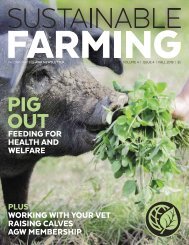Sustainable Farming magazine V5 I2 -- Summer 2020
News: COVID-19: Fight Or Flight; Cattle: Stay In Control; Regenerative Standards Opinion: Britain At Breaking Point? Cover feature: COVID-19 Fight Or Flight Cover feature: New Standard (Certified Regenerative by AGW) Technical: A Brave New World Technical: In Control Of Our Impulses Technical: New Approaches To Worming Technical: The Immune System Technical: Chicken On Grass Certification News: Desktop Audits Meet the Farmer: Lazy A Ranch in Texas
News: COVID-19: Fight Or Flight; Cattle: Stay In Control; Regenerative Standards
Opinion: Britain At Breaking Point?
Cover feature: COVID-19 Fight Or Flight
Cover feature: New Standard (Certified Regenerative by AGW)
Technical: A Brave New World
Technical: In Control Of Our Impulses
Technical: New Approaches To Worming
Technical: The Immune System
Technical: Chicken On Grass
Certification News: Desktop Audits
Meet the Farmer: Lazy A Ranch in Texas
Create successful ePaper yourself
Turn your PDF publications into a flip-book with our unique Google optimized e-Paper software.
CHICKEN ON GRASS
The nutritional contribution of pasture to poultry diets is highly variable
and—generally—very small
Certification news
DESKTOP AUDITS
Pastured chickens will obtain a certain amount
of nutrients from the pasture, as well as insects
and other small invertebrates, and from small
seeds, fruits and berries. Although there is little
consensus about exactly how important each
of these sources of nutrition is, scientists agree
that the potential contribution of pasture (grass,
insects and worms) is highly variable and generally
very small. From a welfare and productivity
perspective, it is therefore vital for pastured
poultry farmers to supply a well-balanced ration
as the primary source of nutrition for their birds.
Nutritional benefits of pasture
Pasture consumption is influenced by a number
of factors, including the amount of time spent
outdoors, foraging behavior, plant species, stage
of growth, palatability and nutritional content of
the plants, and the nutritional needs of the birds.
Breed may also be important, as research shows
that slow-growing breeds adapted to outdoor
conditions will generally utilize forage more
effectively.
The nutritional quality of pasture is related
at least in part to the plant species composition.
Pastures used by many free-range poultry flocks
will have been established for use by cattle or
sheep and may therefore contain species that
are not ideal for poultry production. If poultry
consume largely grass, the nutritional value
derived is likely to be relatively poor. While it
would provide some energy and fiber, the protein
contribution would be low at less than 5% of the
total requirement. However, birds that are allowed
to freely range will also consume a higher
proportion of insects and seeds than those
that have limited access to forage or a small
ranging area. Research shows that pasture intake
promotes growth by improving the consumption
of the grain-based feed, even though the intake of
forage dry matter may be low.
Additional forages
Providing chickens with additional forages to
supplement their diet (and enhance the range)
can have positive welfare impacts. Feeding pea
and maize silages or loose vegetables, for example,
significantly reduced mortality, feather pecking
(including severe pecking) and improved plumage
quality of layers. Providing straw as forage and
feed in mash form has also been shown to
reduce feather pecking.
Nutritional deficiencies
Many nutritional deficiencies in poultry show
similar symptoms, such as reduced growth, poor
feathering and weakness, so it can be difficult to
determine the precise deficiency. Diet analysis,
examination of the management system and
necroscopy may be necessary for accurate
diagnosis. Some nutritional deficiencies are
temporary and reversible upon diet correction.
Article adapted from Farm Health Online.
For more information about practical,
science-based advice on highwelfare
livestock management,
visit farmhealthonline.com
KEY DIET
CATEGORIES
Major nutrients
water; energy;
protein; essential
amino acids
(especially lysine
and methionine);
essential fatty acids
Major minerals
calcium; potassium;
phosphorus;
magnesium;
sodium; chloride
Trace elements
include: iodine;
selenium; iron; zinc;
copper; manganese
Vitamins
A, D, E, K and B12;
folic acid; thiamin,
riboflavin; niacin;
pantothenic acid;
pyrodoxine; biotin;
choline
MIKE SUAREZ
Tim Holmes
explains the
emergency
protocols for
AGW audits
Tim Holmes is
Director of Compliance
with A Greener World
Following the COVID-19 outbreak, AGW
rapidly suspended all travel and on-site facility
audits. In order to ensure the continuation of the
certification process and maintain integrity of
all AGW programs and certified businesses, we
have introduced new temporary protocols and
procedures for remote or ‘desktop’ auditing.
Desktop audits allow us to audit facilities
without physically visiting a farm or business.
They encompass all areas of a standard audit,
including an examination of management plans,
records (including input and output records to
assess input-output balance) and an assessment
of any other relevant information pertinent to
meeting the objective of the audit. The ‘physical’
on-site visit is replaced with an interview with
the facility contact over the phone or by video
conference.
Pre-audit preparation
As your certification renewal date approaches
(and once you have paid your fee), an auditor will
contact you to arrange and schedule your desktop
audit. We can do it by phone or (preferably) video
conferencing such as Skype, WhatsApp or Face
Time. Video conferencing software often allows
screen sharing, which can be a useful option to
verify evidence.
Once agreed, we’ll send you an email with full
instructions, a Self-Assessment Form and a copy
of your previous audit and compliance report
(if applicable). It is important to go through this
carefully. You’ll need to note any changes to your
business on the Self-Assessment Form. We’ll
also ask for copies of management plans and
farm management records, as well as any specific
information the auditor wishes to see. This might
include photos of livestock, housing, feed labels,
ingredients and other relevant documentation
or evidence. Keep copies of all this information
as you’ll need it during the audit to answer any
questions raised.
You will need to complete the Self-Assessment
Form and send it back to the auditor promptly,
along with all requested plans, records and other
information. This enables the auditor to prepare
for the audit day. Please return the assessment
form promptly to avoid unnecessary delays.
On the day
On the day of the audit the auditor will contact
you at the arranged time and explain the plan
for the desktop audit. It is important to choose
a quiet location where you will not be interrupted
and where conversations cannot be overheard to
ensure confidentiality. If you intend to use video
software please choose a neutral background wall
and remove any visible personal information.
The auditor will start by going through the
relevant compliance report questions, referring to
the reference material you have provided, so please
make sure you have the information available.
If for any reason we are unable to complete
the audit in one sitting, your auditor will schedule
a second appointment.
We’ll do our best to make sure the desktop
audit is as painless as possible and appreciate your
cooperation at this difficult time. Please allow up
to five weeks to receive your completed audit and
compliance report.
New facilities or species
New facilities or existing facilities with a new
species will require an on-site visit to certify. We
are currently evaluating travel restriction and the
viral status of different areas. Once it is deemed
safe to travel we will restart on-site audits and
new facilities and facilities adding species will
receive priority status.
If you have any question about desktop
auditing, please get in touch. We would be
happy to discuss the process with you.
22 • SUSTAINABLE FARMING • SUMMER 2020
SUMMER 2020 • SUSTAINABLE FARMING • 23




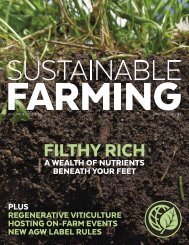
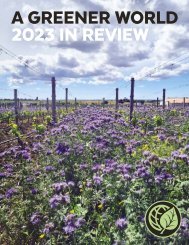
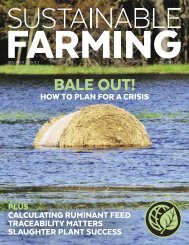

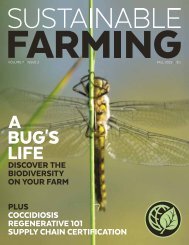
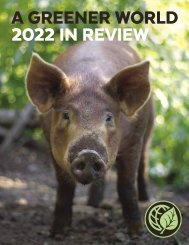
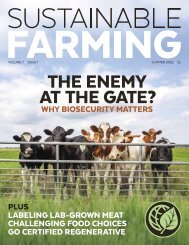
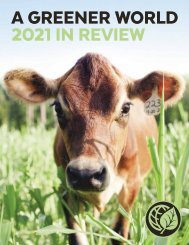
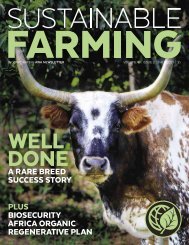



![SF Magazine V5 I1 -- Winter-Spring 2020 [SCREEN ONLY]](https://img.yumpu.com/63122871/1/190x245/sf-magazine-v5-i1-winter-spring-2020-screen-only.jpg?quality=85)
